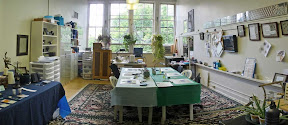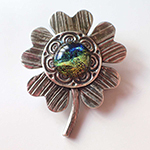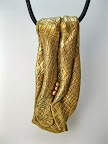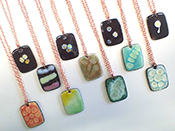Trying Hadar’s White Satin
Posted by C Scheftic on 2014/02/19
Another new clay means another trial making rings!
 Though I love rings–both wearing them myself and admiring those on others, in shops, at galleries–and I love making small adornments using metal clays, in general rings are not my favorite things to make. I’ll leave the reasons for that for another post specifically about rings. Why? Because today I want to talk about rings made from another “new” clay! Now that I’m familiar with a number of different types of metal clay, one of the things I often do to try to get myself comfortable with a new one is to make myself some rings out of it–to test what it’s like to work with–and then wear them everywhere–to test how they hold up. And my first question about an iron-bronze formula in particular was whether it would hold up as well as I might expect under all the stresses I put on rings.
Though I love rings–both wearing them myself and admiring those on others, in shops, at galleries–and I love making small adornments using metal clays, in general rings are not my favorite things to make. I’ll leave the reasons for that for another post specifically about rings. Why? Because today I want to talk about rings made from another “new” clay! Now that I’m familiar with a number of different types of metal clay, one of the things I often do to try to get myself comfortable with a new one is to make myself some rings out of it–to test what it’s like to work with–and then wear them everywhere–to test how they hold up. And my first question about an iron-bronze formula in particular was whether it would hold up as well as I might expect under all the stresses I put on rings.
So one of the first things I made when I got my hands on a (pre-release!) tube of Hadar’s new White Satin was to try making a couple of rings. I wasn’t going to be able to make them my favorite way (with iron in it, I was not going to count on being able to fire the shank first and then form it around a mandrel–a method that pretty much guarantees it will come out a perfect fit–and I was too eager to try it to first make a little test strip to see if/how I could manipulate it, though if will try that eventually…). And I didn’t want to make a ring using the “common” metal clay way, shaping a band in the clay-state (with lots of potential shrinkage-issues during firing). So my first White Satin rings were a pair of seamless stackers with each one textured on one side (using the “eastern paisley” design from Cool Tools) and plain on the other side.
 My plan was to make them two different shapes, and wear them with the “plain” sides together. And, no, they didn’t warp during firing: I made the openings oval on purpose!
My plan was to make them two different shapes, and wear them with the “plain” sides together. And, no, they didn’t warp during firing: I made the openings oval on purpose!
I usually make my rings either oval (as shown here) or square-ish (a rounded-corners trapezoid). The latter is easy with metal I can whack around something like the finger-shape mandrel from Rio Grande. Since I wasn’t yet ready to try that with White Satin, I just cut the clay itself with an oval opening. Hadar said rings would shrink about 3 sizes, so I used that for my beginning estimate.
Though, since I was making my rings oval, I did cut the opening a tad smaller than that. What I really did was to fit a narrow strip of metal inside a ring sizer at the +3 size, but then trim it a tad smaller. I then shaped that into an oval, and used that to cut my clay. The reason for down-sizing a tad is that, to put on an oval ring, I turn it sideways until it’s passed over my knuckles, but then turn it back up to wear. The “twist” allows the larger-direction opening (still at the +3 size) to fit over the larger-dimension part of my finger. But when it gets twisted back again, the straighter side (now smaller and narrower) holds each ring upright better, so I don’t have to keep straightening them.
The rings shown here were fired and then polished. And they did come out fitting the finger for which I was trying to make them! Since they contain iron, which will rust, they were sprayed with an acrylic protectant. Since they are rings, I have no clue how long that protection may or may not last. That’s what I’m now trying to test! I’ve been wearing them off and on for almost two weeks (more on than off, but nowhere near constantly) before taking these snapshots. They seem to be holding up fine in the short term. It’ll just take more time to see how they do over a longer stretch.
In the meantime, I am very happy with the results so far, and I hope you appreciate this early-report.
~~~~~
Update: This post originally referred to White Satin as a form of steel. I have since decided that it is more appropriately described as a form of iron-bronze, and have edited the post to reflect that. (Bronze is an alloy of copper and tin. Different proportions yield metals of a different color. Rose bronze, for example, has more copper than does the typical yellow-bronze. White bronze has more tin. which produces a nice color when used as an accent, but results in a metal that is too “fragile” to be used as a major structural component. Hadar’s White Satin is a bronze formula that contains some iron too, which produces a black-metal that can be polished to a white-metal color but has the strength more like that of a typical bronze….)
This entry was posted on 2014/02/19 at 13:00 and is filed under General Techniques, Learning Metal Clay, Technical Details. Tagged: Hadar's Clay, iron bronze, rings, steel, White Satin. You can follow any responses to this entry through the RSS 2.0 feed. You can leave a response, or trackback from your own site.
6 Responses to “Trying Hadar’s White Satin”
Leave a comment Cancel reply
This site uses Akismet to reduce spam. Learn how your comment data is processed.

 Artsmiths of Pittsburgh
Artsmiths of Pittsburgh Hoyt Center for the Arts, New Castle, PA
Hoyt Center for the Arts, New Castle, PA Portage Hill Gallery, Westfield, NY
Portage Hill Gallery, Westfield, NY _Open Houses in my Studio
_Open Houses in my Studio _Or…contact me about hosting a private party!
_Or…contact me about hosting a private party!
Cynthia pope said
Carol, another wonderful blog post. Someone asked me today if steel can be hammered around a mandrel. I said I didn’t know but I have a friend who I know will try it. Can’t wait.
LikeLike
C Scheftic said
Thanks,Cindy. It may take me a few weeks before I have a good set to report, but I plan to test that for all the new clays I brought back from Hadar’s (followed, asap, by any other one-fire versions as soon as I can get my hands on those). I’ll post the news here.
Timing is uncertain in part because, though I made all my connections and arrived back safely (with my carry-on bag of jewelry and tubes of drying-out clays), my checked baggage (checked, of course, because it’s full with all my MC tools!) was selected to take a more circuitous route home…
LikeLike
Alice Walkowski said
Saw the new steel advertised on the Metal Clay supply. It looks pretty. Too bad it rusts.
LikeLike
C Scheftic said
Yes, Alice, it is a lovely color. I like it textured, personally, more than when it’s just plain, but then textures are what I like about pieces produced from metal clays overall.
As to the rust, it’s not going to do that any more than any other non-stainless steel. (As I understand it, stainless is possible with the metal clay process but, at least so far, it requires a higher heat than our kilns can provide using basic household current.) So I don’t plan to produce a plethora of rings with this steel, because of the wear and water that rings suffer, though I’ll make a few more for my own testing purposes. But for pendants, pins, earrings, etc., some basic sealing (acrylic, wax, oil, etc.) should protect the piece from rust. Yes … more testing to come! (And, more work in the bronzes: I really like some of the colors there!)
LikeLike
Jenny E. said
Ooooh I love them!!! I am struggling a bit with Hadar’s clay; sometimes it just doesn’t sinter no matter what (and when I raise the temperature, they blister….) sometimes I have to fire for 12 hours…. but will keep trying!!! Love, Jen
LikeLike
C Scheftic said
Thanks, Jenny E. But, seriously, 12 hours? Why?!! If you’re firing hot enough (just under the “blistering” temp) and long enough (2 hours should be all that’s necessary), then there are really only two possible things going on:
(1) your kiln is spiking higher than you think (giving you some blistering when most of the time it’s not really hot enough) or, more likely,
(2) you’re not burning off all the binder before you reach the goal (sintering) temperature.
If you have not yet read all of Hadar’s Quick-fire Clay Instruction Manual (esp. pp 30-32 in the current version, it’s the section on “Understanding Metal Clay and the Firing Process,” then I’d suggest you start there. (Well, another possibility, separate from sintering as such, is that the pieces are breaking down because too much carbon is burning off in those super-long firings.)
Hang in there! Each combo of clay(s) + kiln + firing vessel + carbon + locale + designer is a little bit different. But not a lot different… Once you figure out your own “sweet spot” for these clays, you’ll be all set!
LikeLike